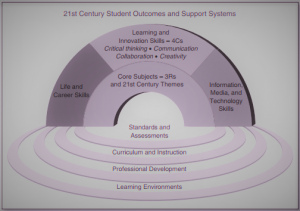The problem with the No Child Left Behind mandate is that it is designed to force the teacher to constantly turn back and check if all the “little ducklings” are keeping up (read constant testing). The only way to fix this is with a balanced approach of the teacher leading by good example but at the same time putting the child first. Thus, my response to the chaos created by the No Child Left Behind mandate is the Child First approach to education. When you have the children in front of you there is no need to keep looking back and make sure that no one is off course.
Many educators do recognize the need to teach more than the 3 R’s. A depiction of an expended student curriculum reflecting our expanded knowledge can be seen here (See graphic page 6) https://www.corwin.com/sites/default/files/upm-binaries/49911_Greenstein___ch1.pdf
 However, remember this approach of changing the curriculum is still short sighted, as it fails to keep the needs of the individual student in mind. I had a babysitter once who insisted an apple a day keeps the doctor away. I tried explaining that my child was extremely sensitive to apples and was fine with peaches, plums, pears and the like. She refused to accept this. Her winning argument? She had raised her children with this method and therefore it had to be good for my daughter too, in spite of the overwhelming evidence to the contrary?!?
However, remember this approach of changing the curriculum is still short sighted, as it fails to keep the needs of the individual student in mind. I had a babysitter once who insisted an apple a day keeps the doctor away. I tried explaining that my child was extremely sensitive to apples and was fine with peaches, plums, pears and the like. She refused to accept this. Her winning argument? She had raised her children with this method and therefore it had to be good for my daughter too, in spite of the overwhelming evidence to the contrary?!?  (Yes, I fired her).
(Yes, I fired her).
So long as children are treated like identical machines off an assembly line, to be programmed and then fixed when they fail to perform, we will continue to fail at education. This idea was portrayed so eloquently by Sir Ken Robinson in this classic animation, viewed nearly 2 million times, https://www.ted.com/talks/ken_robinson_changing_education_paradigms . A machine lacks emotion, and thus lacks that feeling we call “drive”, therefore motivation does not get taken into consideration in getting a computer to perform. A human being on the other hand is born only feeling and part of what we want to teach the child is to learn to control his emotions. Not reject or deny the feelings, but to control them rather than letting them control you.
Discipline is NOT about punishing the child. It is about teaching the child self-control and restraint. The following should illustrate the point clearly. We all want to keep children safe. One way in which we do this is to teach them about street safety. We give instructions such as “cross at the cross-walk, not in between cars, look both ways,” etc. When do you instruct the child? As soon as he starts to walk? Obviously not! He has to be developmentally ready. This means he has to be able to see, has to control his impulsive desire to dash along his merry way and exhibit the cognitive understanding of the danger of moving vehicles. Hopefully as an NLP minded teacher (see Don’t Be A Pedagogue) you model and explain how you cross the street and as a good leader you model proper street crossing. You then give the child an opportunity to demonstrate he has learned what you have taught him. He will have to do this until he has demonstrated mastery and only then will you let him cross independently.
![]() Keeping the goal AND your student in mind will let you both achieve success. If the child in question is too impulsive, blind or doesn’t understand the dangers, then understandably now may not be the time to teach him to cross the street, EVEN IF all his same aged peers are doing so.
Keeping the goal AND your student in mind will let you both achieve success. If the child in question is too impulsive, blind or doesn’t understand the dangers, then understandably now may not be the time to teach him to cross the street, EVEN IF all his same aged peers are doing so.
The Child First approach uses goals that are relevant to the child being taught, rather than an age based curriculum designed to meet pedagogical standards or goals that are for the convenience of the one doing the teaching. Materials and engagement are based on the child’s developmental level and interests rather than a textbook.
![]() Think about your thought process. Are you teaching your child toileting because it is convenient for you, or perhaps pushing it off because the timing is not good for you even though your child is clearly ready? Do you make your child do household chores because you want the help or because s/he needs to learn the skills and responsibility? Are your classroom lessons and environment designed with the child in mind or for your convenience and ease? Do you demand blind obedience or do you have a respectful relationship with your student(s)?
Think about your thought process. Are you teaching your child toileting because it is convenient for you, or perhaps pushing it off because the timing is not good for you even though your child is clearly ready? Do you make your child do household chores because you want the help or because s/he needs to learn the skills and responsibility? Are your classroom lessons and environment designed with the child in mind or for your convenience and ease? Do you demand blind obedience or do you have a respectful relationship with your student(s)?
Next time: What should you do when learning does not occur?
Best,
![]()



